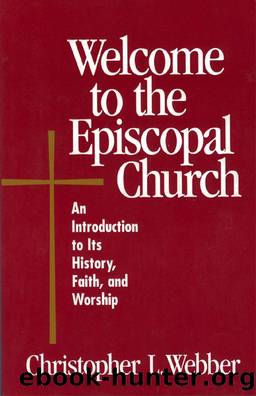Welcome to the Episcopal Church by Christopher L. Webber

Author:Christopher L. Webber
Language: eng
Format: epub
Publisher: Church Publishing Inc.
Published: 2017-05-09T00:00:00+00:00
1. Robert Bellah, ed., Habits of the Heart: Individualism in American Life (Berkeley and Los Angeles: University of California Press, 1985), p. 221.
5
Spirituality
THE SOURCES
No one knows when Christianity first came to the British Isles, but there is a legend that Joseph of Arimathea, who gave the tomb for Jesusâ burial, came to Britain after the Resurrection, bringing the cup that was used at the Last Supper, and that he built a church at Glastonbury, in southwestern England. If so, there may have been a church in England before there was one in Rome. Whether or not that is true, it is clear that Christianity came to England at a very early date since three British bishops attended a synod in France in A.D. 314 and other British bishops attended the Council of Nicaea in A.D. 325. But pagan Germanic tribes called Angles and Saxons invaded Britain in the sixth century and pushed the British church into Wales and Ireland. Before long, however, this early British or Celtic church pushed back with amazing energy, sending missionaries into Scotland and the north of England, then into the Low Countries and Germany, and finally as far east as the Ukraine and as far south as Italy. Nonetheless, it was the Roman Church, moving north, which began the conversion of the Anglo-Saxons in the year A.D. 597, when Pope Gregory sent a man called Augustine, who began his work by founding a church in southeastern England at Canterbury. That Roman mission from the south finally met the Celtic Church from the north, and at a synod in Whitby in the year A.D. 664 that was called to resolve the differences between them, the Celtic Church agreed to adopt the Roman pattern of Christianity.
Nonetheless, the Celtic approach left its mark on the church in England. The Celtic Church was much more loosely organized than the Roman Church; it had monastic communities as centers of teaching and mission rather than territorial dioceses centered on a bishop. In the Celtic system, the abbot ruled the monastery and the surrounding area as father of a family, while the Roman bishop directed the administration of the diocese as an overseer. The Celtic Church also made few distinctions between roles for men and roles for women; women were ordained to the priesthood and consecrated as bishops in Ireland as early as the seventh century. Celtic Christianity also was closer to nature and thought more intuitively about the faith. It was, as we have learned to say, more âright brainedâ in its approach. The great hymn known as âSt. Patricks Breastplateâ and attributed to St. Patrick reflects that way of thinking. It feels the presence of God in nature, in âthe flashing of the lightning free, the whirling windâs tempestuous shocks, the stable earth, the deep salt sea around the old, eternal rocks.â1 And it feels Christâs presence in human life: âChrist within me... Christ beside me... Christ in mouth of friend and stranger.â The familiar childrenâs hymn that begins, âAll
Download
This site does not store any files on its server. We only index and link to content provided by other sites. Please contact the content providers to delete copyright contents if any and email us, we'll remove relevant links or contents immediately.
| Anglican | Baptist |
| Book of Common Prayer | Calvinist |
| Episcopalian | Inspirational |
| Lutheran | Methodist |
| Pentecostal & Charismatic | Presbyterian |
| Quaker | Seventh-Day Adventist |
| Shaker | Theology |
Angels by Billy Graham(1889)
How To Be Born Again by Billy Graham(1732)
Peace with God by Billy Graham(1643)
Unbroken Curses by Rebecca Brown & Daniel Yoder(1522)
God's Prophetic Symbolism in Everyday Life by Adam Thompson & Adrian Beale(1448)
The School of Biblical Evangelism by Ray Comfort(1393)
Call by Rick Joyner(1370)
Martin Luther: The Man Who Rediscovered God and Changed the World by Eric Metaxas(1355)
Power over the Enemy by John Osteen & Joel Osteen(1316)
Jonathan Edwards: A Life by Marsden George M(1195)
Fresh Wind, Fresh Fire by Jim Cymbala(1192)
Prayers That Bring Healing and Activate Blessings: Experience the Protection, Power, and Favor of God by John Eckhardt(1189)
Liturgy of the Ordinary by Tish Harrison Warren(1182)
The Supernatural Power of a Transformed Mind Expanded Edition: Access to a Life of Miracles by Bill Johnson(1173)
Unmasking the Devil: Strategies to Defeat Eternity's Greatest Enemy by John Ramirez(1162)
An Altar in the World by Barbara Brown Taylor(1154)
Reformation Theology by Littlejohn Bradford(1146)
Seeing the Voice of God: What God Is Telling You through Dreams and Visions by Smith Laura Harris(1104)
Martin Luther by Mansch Larry D.; Peters Curtis H.;(1104)
